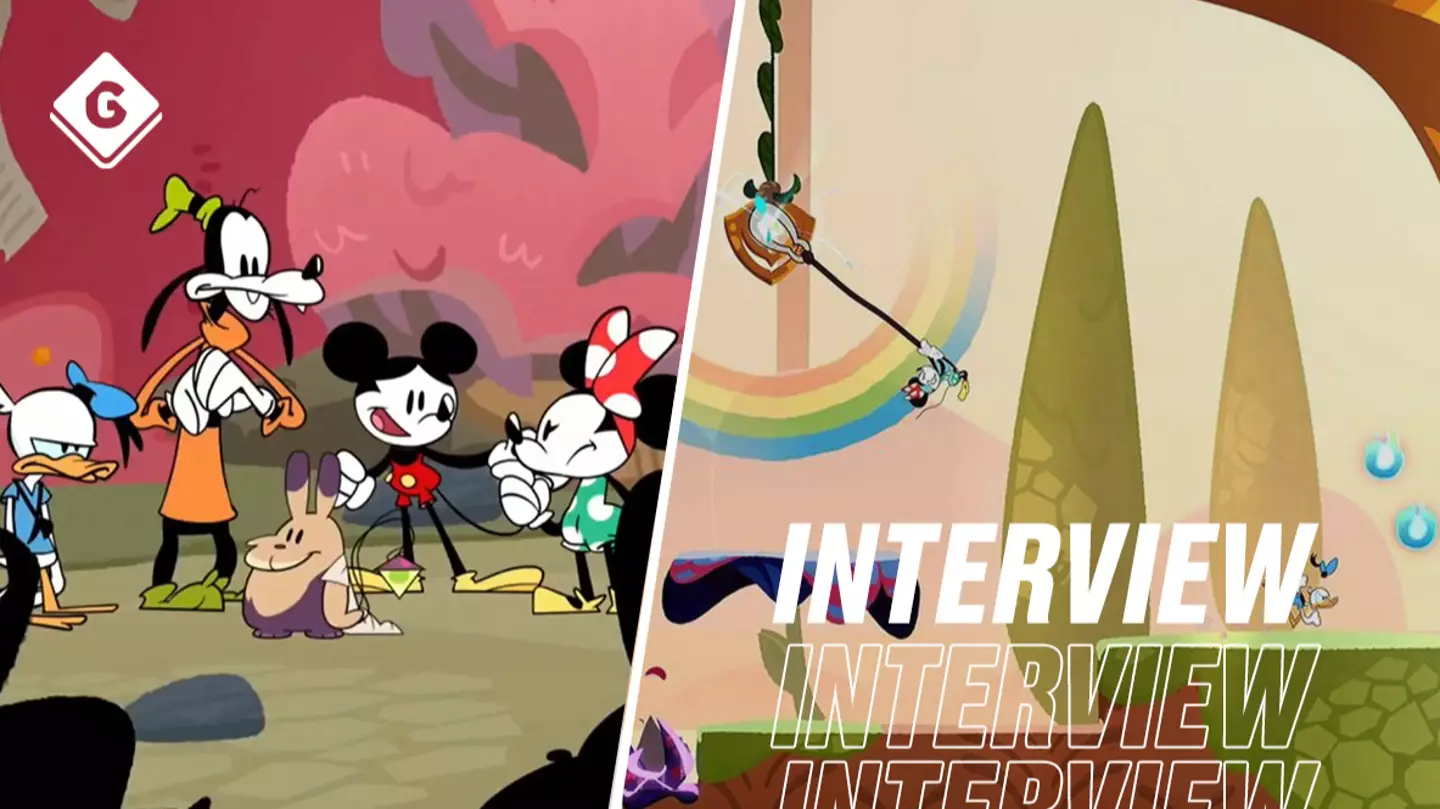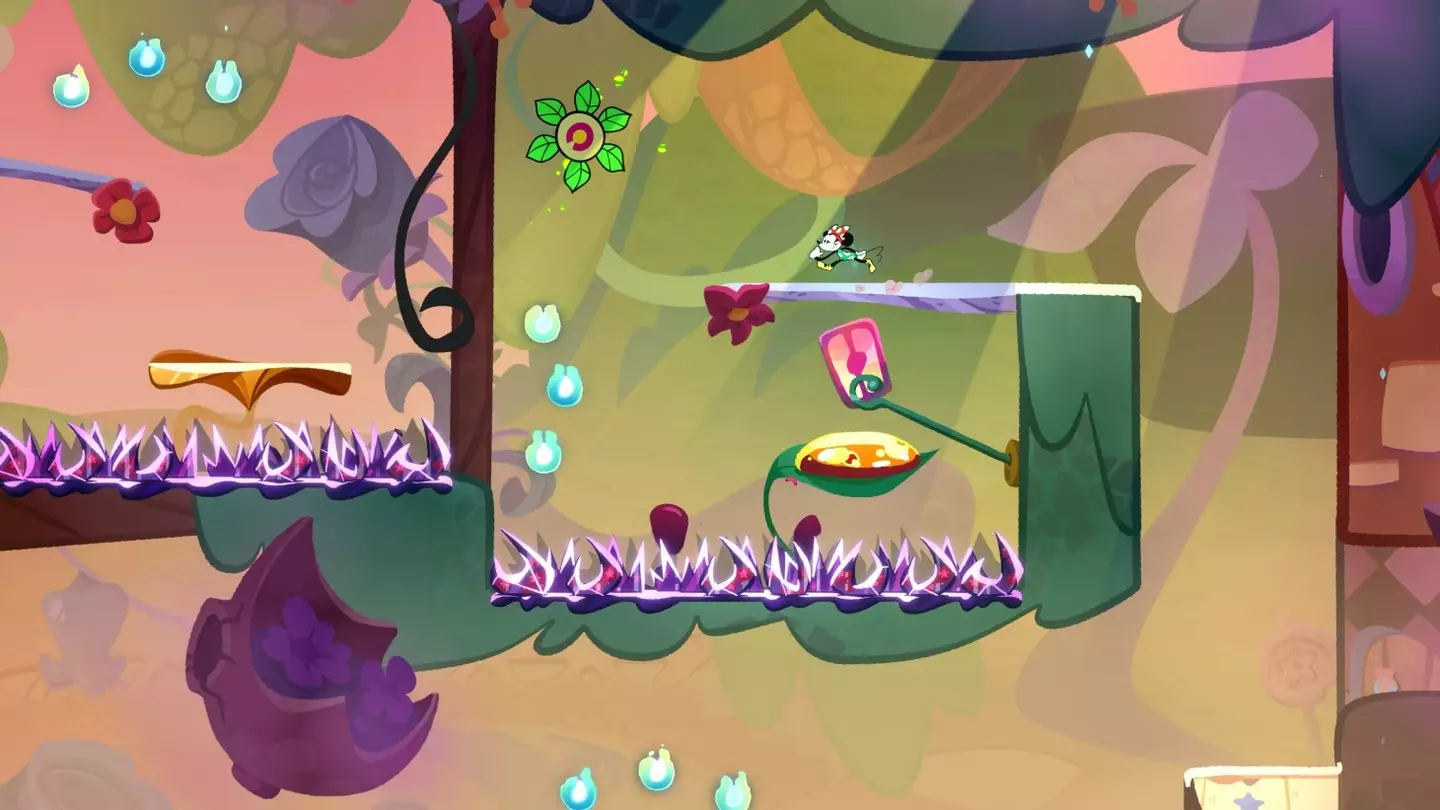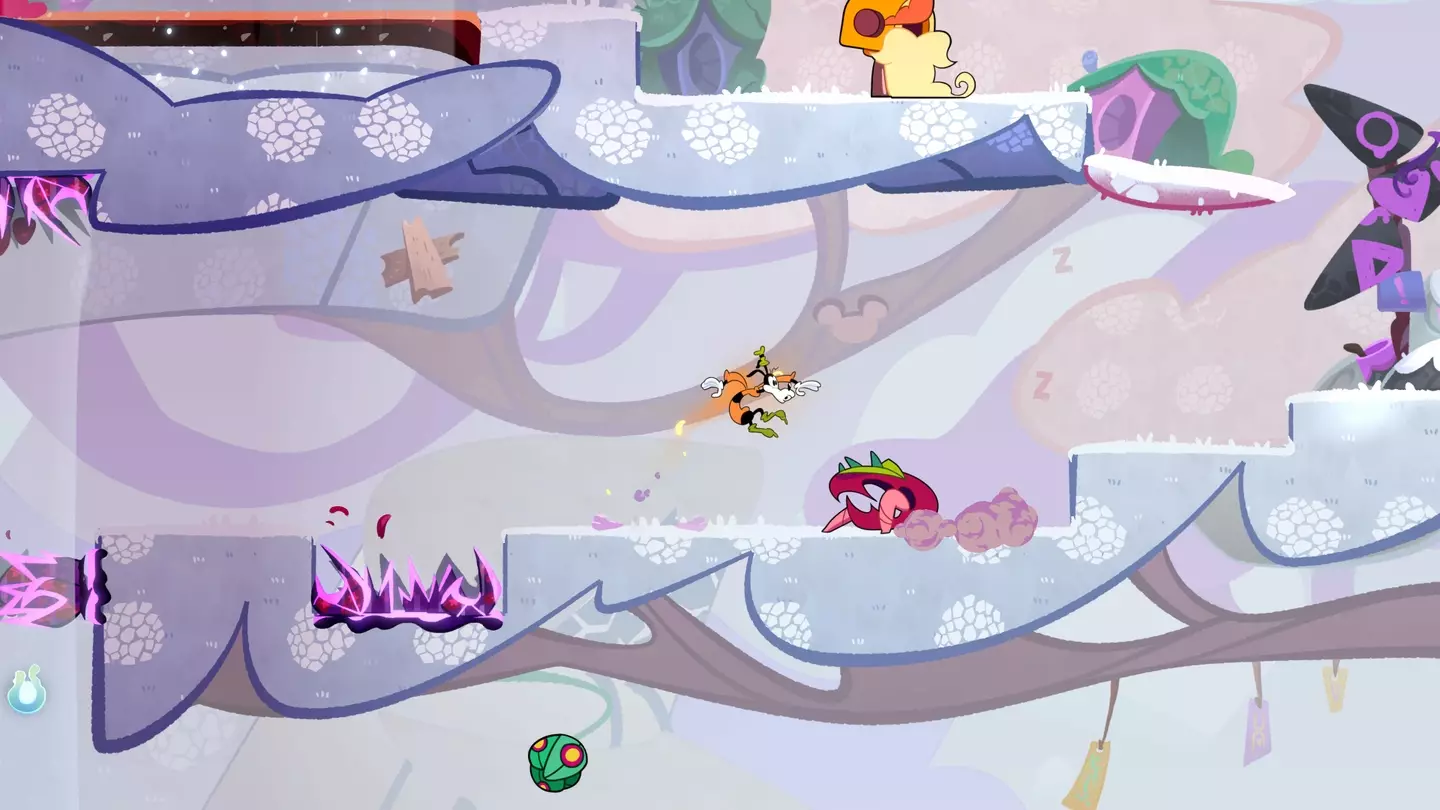
Disney is currently in the midst of celebrating its 100th birthday, so it feels apt that the company’s latest gaming venture, Disney Illusion Island, stars the classic characters that started it all: Mickey, Minnie, Goofy, and Donald. Developed by Dlala Studios, Disney Illusion Island is a Metroidvania with a twist. Free of combat, players will be tasked with traversing the sprawling island of Monoth either on their own or with the help of up to three friends.
Disney Illusion Island looks utterly delightful, and it sounds as if it’ll boast a charming story too. Mickey and friends are tricked into venturing to Monoth by the island's inhabitants. Three magical tomes, used to protect Monoth, have been stolen and it’s up to you - the player - to set things right. We had the opportunity to sit down with Dlala Studios’ CEO and creative director AJ Grand-Scrutton, who worked on the game, alongside lead designer Grant Allen. Together, we discussed the challenge and delight that it is working with such iconic characters, how Illusion Island is suitable for all ages, and what kinds of Easter eggs fans can expect to find.
Before we dive in, take a look at Disney Illusion Island in action below.
Disney Illusion Island can be enjoyed either as a solo adventure, or with up to three friends via co-op. Can you tell me more about how tackling the platforming puzzles will differ between those two modes?
Advert
Grant Allen: The puzzles are the same in both single-player and co-op but the way they’ve been designed is so there’s a clear path in single-player. But when you're in multiplayer, there's always something extra for the other players to do which helps with the end result of the puzzle. When we were designing these puzzles, they’ll always have a key goal with several mini goals within that. We wanted everyone to be able to take part in getting to that finish point, but there’s also something enjoyable in [tackling it in co-op]. The ethos we had was awesome alone, better together.
From a multiplayer perspective, players can figure out and complete these puzzles quicker. You can use your group to say, ‘You go there, you go there,’ and you get this kind of a chain reaction solution - rather than single-player when you’re doing every part of the path yourself.
Leading on from that, Disney Illusion Island is aimed at all ages. How did you differentiate the difficulty to cater to varying audiences?
Grant: We wanted to look at it as a family game. There are settings that, say if me and AJ wanted to play, we could feel challenged but we also wanted to be able to play with nieces and nephews. We looked at health and how that could be differentiated between players. When you look at other games, health is usually a universal setting. We looked at splitting that so each player can individually choose their starting health hearts.
Advert
You can change this during the gameplay so if it’s too difficult or easy, you can lower or increase your health [per individual player]. There are other settings players can adjust including assistance with wall climbing and with timed aspects of the game. We wanted to make it as welcoming as possible to as many people as possible. Mickey [Mouse] is for everyone, so the game should be for everyone.

The island of Monoth is split into three biomes. What can you tell me about the unique obstacles and challenges they’ll each pose?
AJ Grand-Scrutton: It was super important for us that the island of Monoth felt like a seamless world, and yet each area had its own infrastructure, style and feel. We have three main biomes. Pavonia is all about botany and botanical magic. There’s the overgrown Forgotten Farmlands where you can see plant life has thrived. Then, there’s Terrarium Town which is where the well-off residents of Monoth reside.
Advert
The next biome is Gizmopolis. It took inspiration from Wallace & Gromit. Let’s make some gadgets out of trash, kind of a feel. And then, we have Astrono - the strange one. It’s a mixture of astrological and oceanic magic. The idea is that one of the moons crashed and the juice from the moon combined with the ocean to create this underwater galaxy called Sky Below.
They all look different, feel different, and sound different. The audio soundscape and the music is very different in each of the areas, showcasing their own unique personalities. And even the people that inhabit those areas, you can see certain quirks. The residents of Pavonia are often seen wearing flowers, so you’ll be able to spot them in other biomes.
Grant: Once we’d got a feel for the three biomes, we started thinking about what mechanics we wanted to include in each one. I'm thankful that the designers were so good at coming up with mechanics that we ended up taking out some ideas, just to make sure that those we did include had room to breathe. In Pavonia, there are fun Venus Flytrap platforms. In Astrono, there are constellation platforms where, as you run towards them, constellation lines will appear linking the different stars. Without saying too much, there’s some fun stuff with buttons, moving platforms and moving walls. We just wanted to make sure that each biome felt very unique both visually and mechanically.
The trailer mentions ‘special abilities’ and unlocking ‘secret areas’. Can you tell me more about unlocking abilities in the game? Is there an upgrade path?
Advert
Grant: The game has critical threads that run through it, so all of these abilities will be acquired as you go through the main path of the game. We have a couple things to help players do that. So if you pass something you can’t use, or you’re unsure how to use it, that leaves a question mark on the map. Once you unlock the ability linked to that obstacle, you’ll be able to see all the places you can go back to.

There are clearly Metroidvania influences here, but Disney Illusion Island doesn’t include combat. What kind of games were you influenced by, and how did you go about setting Illusion Island apart from those influences?
Grant: It took a while for us to come around to the idea of no combat. We kept saying, ‘It's a Metroidvania, it has to have combat.’ Then we got to a point where the vision became clearer and we realised combat didn’t make any sense. This game is about the freedom and joy of the movement. Combat would halt the pacing. As for influences? That's a really good question, because most do have combat in them. You know, like Hollow Knight, Gato Roboto, Ori and the Blind Forest … I think in our heads it was a hard decision to say we’re not going to have combat but then when we did get rid of it, it became clear that it wouldn’t suit the game or characters.
Advert
AJ: Something we haven't really spoken about in previous interviews is the fact that enemy design led us to this decision. At one point, we were going to have you jump on an enemy’s head. Every platform game in history knows that language - we wouldn't have to teach it to the player. Then we put the enemies into the game and there were about two you could do this on. It didn’t make sense for the rest, so then you start asking, ‘Maybe we don’t want combat in the game if the game isn’t asking for it?’
Once we made the decision, Disney was completely on board. It felt silly that we’d considered combat. Grant touched on most of our influences. Obviously, the game is very platform heavy, so we played all the old platform games. There's people on our team that didn't even know what the Mega Drive was, so we had to get the Mega Drive out and show them that and the SNES. We looked at so many classics. Also, Rayman Legends - that is just arguably one of, if not the best, 2D platformer ever made. A real spread of getting the team to play as many kinds of reference points as possible.
What can you tell me about the scale of this world and how you navigate it?
AJ: Backtracking is critical, but it’s very fluid and natural. You’ll come across mechanics that take some time out of longer journeys. If you want to see everything Monoth has to offer, including all the hidden nooks and Easter eggs, you can seamlessly backtrack around the map. Grant’s team did a great job at building areas full of reasons to come back to them with each ability you unlock. That’s certainly the case with those early areas of the game, where you initially have fewer abilities.
The whole world is seamless. You can walk from one end of Monoth to the other. Once you're through that initial loading screen in the game, there are no more (unless you choose the mechanic which incorporates them). There’s some fast travel stuff that pops up later, so yeah. You can really just completely explore this world.
.webp)
What’s it like working with such iconic Disney characters?
AJ: Great question. We've never felt pressure from Disney. The pressure has always come from us. I remember messaging Grant saying, we cannot mess this up. Mickey’s very special. He’s special to us and so many others. We’re making a Mickey Mouse game because we love Mickey Mouse. A huge section of my office is dedicated to Mickey Mouse memorabilia. We wanted the game and characters to feel authentically Disney, distinctly Dlala.
Grant: I tried to not think about who the characters were for the first couple of months to lessen the pressure. And then as soon as the animation and pencil tests came in, I was like, ‘I've just got to embrace it now.’ We just wanted to do these characters right for the fans.
Each character functions the same, but I know they each have their own personalities. Did you have a favourite to play as?
AJ: Minnie is my favourite. She's just awesome in general, but she has some really special animations. There’s a great leapfrog one where she does this flip.
Grant: It's always gonna be Donald for me. There are a lot of Donald lovers in the studio.
You mentioned that fans will stumble across Easter eggs. What kind of Easter eggs can players expect?
AJ: I can’t spoil too much but we have several types of collectibles in the game, and one of those is celebrating 100 years of Disney through Disney icon Mickey Mouse. You will find stuff in there that goes all the way back to Steamboat Willie, as well as modern shorts. It’s very Mickey and friends centric, but there are a few other things to look out for. A couple of story cutscenes might link to the wider Disney world.
Have you thought about there being another adventure for Mickey and friends beyond the events of Illusion Island?
AJ: One hundred percent. I can’t commit to saying there’s an Illusion Island sequel or anything like that, but we’re not ready to give these characters up and move on from this world. This is longer than we’ve spent on any other title. We could keep going. There are plenty more stories to tell in Monoth with these characters. All we can say is we hope the game does well enough that there’s a reason for us to come back and do DLC or more titles. We just know we’ve loved making this game and would happily stay in this world longer.
Disney Illusion Island will release on Nintendo Switch on 28 July.
Featured Image Credit: Disney Interactive StudiosTopics: Disney, Nintendo, Nintendo Switch, Interview